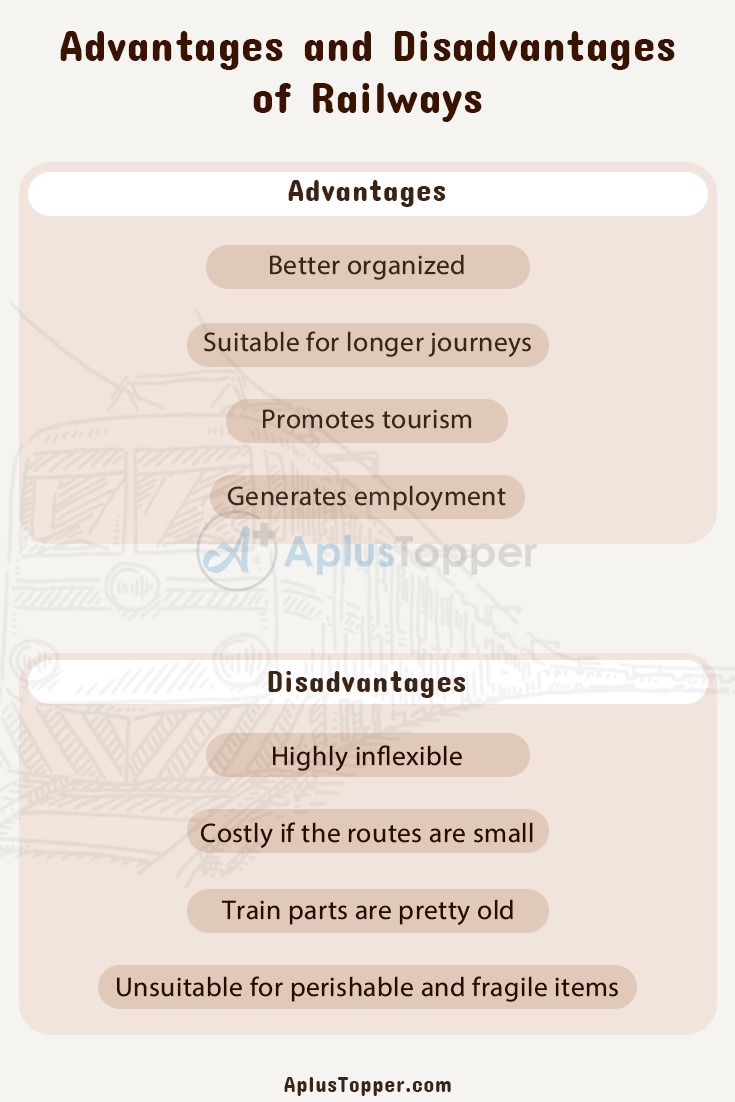Advantages and Disadvantages of Railways: Railways are by far one of the most important means of transportation in today’s world. The first-ever railway line was constructed between Thane and Mumbai, which was almost a 22-mile stretch. In the beginning, the operation of railways was solely done by several private companies owned by numerous Englishmen. But in the year 1950, this ownership was transferred to the Government of India.
Students can also find more Advantages and Disadvantages articles on events, persons, sports, technology, and many more.
What are Railways? Advantages and Disadvantages of Railways 2021
For any country, the transportation of various goods takes place through various means, including air, road, and railways. However, among all of these, it is the railway system that has gained maximum popularity. Railways mean transporting various goods utilizing train, from one spot to the other. It is a vehicle that only runs on tracks and can transport huge loads within a short period. It is one of the safest transport systems on land.
- Advantages of Railways
- Disadvantages of Railways
- Comparison Table for Advantages & Disadvantages of Railways
- FAQs on Pros & Cons of Railways
Advantages of Railways
There are numerous advantages to railways as a means of the transportation system. They are listed as follows:
- Organized: The railway transportation system is considered to be better organized when compared to other modes of transportation, like roadways or waterways. Not only does the railway have its routes fixed, but it also runs on packed schedules. This makes the railway service more certain, regular, and uniform in comparison to other transportation modes.
- Dependable: This is by far the most significant advantage of this mode of transportation. Railway transport is perhaps the most dependable form of transport. It is hardly affected by extreme weather events like cyclones or similar weather conditions like fog or rain. Even with much-reduced visibility, the railways will keep on functioning.
- Suitable for bulky goods: Railway transport is the most economical transport system. It is also quicker and the best option for transporting heavy or bulky goods, like vehicles, furniture, raw materials for industries, and so on, over long distances.
- Employment: Railways are considered to be an essential source which generates employment in our country. Numerous skilled and even unskilled people get employed in this sector. There are numerous job scopes in this sector, and it provides a steady source of income. Railway transport also helps numerous people to carry or transport their cheap products from one spot to another. It allows them to sell these products at a profitable price. Thus, quite a several people, otherwise unemployed, can find employment.
- Social and strategically important: Railways have been very successful in shortening the distance and have also developed the mindset of people. They are pretty helpful for the internal security of the country. They carry the invaluable defense material, in cases of external aggression, to several locations.
- Cheap means of transporting goods: Railway transport is cheaper than air transport. If railway transport is compared to roadways, then it is because, through railway, goods can be transported in bulk quantities from one destination to the other. Most of its expenses are fixed costs. If there is an increase in the traffic or frequency of the railway, then it is immediately followed by a considerable decrease in fare or cost. It is highly economical in the aspect of labor use also. It takes only one person each as a driver and guard. This is sufficient to transport more load when compared to any other transport sector.
- Higher load capacity: The carrying capacity, both in terms of passengers and freight, of the railways, is quite large. One even better thing is that the capacity of railways is elastic. It is elastic because the capacity can be increased easily, as per requirement, by adding more carriages or wagons.
- Encourages tourism: Various tourism spots throughout the country is well connected via railways. So it is beyond doubt that railways are responsible for promoting the tourism industry.
- Agricultural development: Railways have helped to commercialize agriculture. Nowadays, the farmers not only produce for consumption in their households but also for selling purposes. The railways help in the safe transportation of these products.

Disadvantages of Railways
There is hardly any doubt that railways are quite the backbone of the transport system in our country. However, the opposite side of the railway coin is that there are quite some disadvantages to it. These are listed as follows:
- Not safe for perishable and fragile items: Railway transportation is considered particularly unsafe for the transportation of certain items that are either perishable or fragile. Railways are unsuitable for fragile goods, like those made of glass, or perishable commodities like food. These items are easily breakable or can perish if packed for too long. At times, the trains can take unexpected halts or speed up quickly, breaking the fragile goods.
- Not suitable for rural or hilly areas: The Indian villages lack a proper railway system to date. The tracks are not build up properly in these villages. As a result, railway transport proves to be entirely unsuitable in these areas.
- Door-to-door services are not available: Railways are pretty limited to their tracks and thus fail to provide any immediate door-to-door service. The costs of unloading or reloading at a particular station also prove to be a costly affair.
- Not suitable for shorter distances: For shorter distances, road transport is much more feasible. The railways are costlier if the distance is less, and this is quite a disadvantage.
- Replacement issues: All the coaches, wagons, and even the engines are pretty old in our country. These are urgently needed for replacement, which is quite costly and makes the government think twice about their expenditures.
- Issues with double line laying: To date, most railway tracks are yet to be double-lined. They are single lines, which proves to be inconvenient to both passengers and even the railway authorities.
- Inflexible: Both the routes and the timings of the trains are fixed. They can never be adjusted according to individual needs, and thus, this makes railways relatively inflexible.

Comparison Table for Advantages & Disadvantages of Railways
| Advantage | Disadvantage |
| Better organized | Highly inflexible |
| Suitable for longer journeys | Costly if the routes are small |
| Promotes tourism | Train parts are pretty old |
| Generates employment | Unsuitable for perishable and fragile items |

FAQ’s on Pros & Cons of Railways
Question 1.
What type of items can be transported through railways?
Answer:
You can transport several items like flours, pulses, or heavy products like cement or iron through railways. Steel and other such raw materials for industries are also transported through railways. It is always advised not to transport breakable goods, like glass, through railways.
Question 2.
What are some types of railways?
Answer:
There are a few types of rail transport. Some of them are rapid transit railways, which are high-speed railways. Then there is the light rail, which can also be very light or ultra-light rail. There are elevated railways, commuter railways, and cable railways too.
Question 3.
Why are railways not suitable for hilly areas?
Answer:
The main reason for hilly areas not having much railway system is the topography of the mountains. The uneven terrain and rough topography make the construction and maintenance of hilly regions difficult.
